|
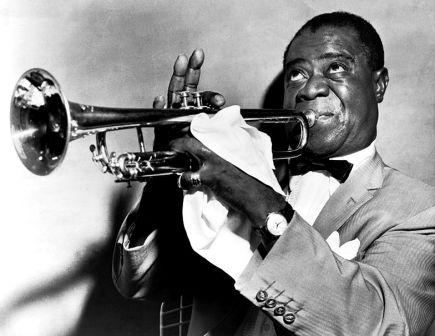
Louis Armstrong -
The Jazz Age
|
Jazz Age Facts for kids: Fast Fact Sheet
Fast, fun facts and Frequently Asked Questions (FAQ's)
about the Jazz Age.
What was the Jazz Age? The Jazz Age
was the era in American history that started
with the end of WW1 and ended with
the Great Depression of 1929 when jazz
music, modern ideas, flappers and dance
became popular.
Which decade was known as the Jazz Age?
The decade known as the Jazz Age was the
1920's, also known as the Roaring Twenties.
Which phrase describes the Jazz Age?
The words and phrase that best describes the Jazz Age
is: "The period of the Jazz Age is
associated with sophistication, modernism,
exuberance, consumerism and decadence and
the introduction of jazz music". Also read
the following Jazz Age quotes!
The Jazz Age for kids: Jazz Age Quotes
The following Jazz Age quotes typified the
era:
Famous Jazz Age
Quotes for kids
Jazz Age Quotes:
"Jazz does not belong to one race or
culture, but is a gift that America has given the
world." - Ahmad Alaadeen, a jazz saxophonist
Jazz Age Quotes:
"Jazz washes away the dust of every
day life." - Art Blakey, American jazz drummer and
bandleader
Jazz Age Quotes:
“...the greatest, gaudiest spree in
history” - F. Scott Fitzgerald, Author of the Great
Gatsby
Jazz Age Quotes:
"Why on earth do you need to study
what’s changing this country? I can tell you what’s
happening in just four letters:
A-U-T-O." - Helen Lynd, Author
Jazz Age Quotes:
"One thing I like about jazz, kid, is
that I don't know what's going to happen next. Do you?"
- Bix Beiderbecke, Jazz Musician
Jazz Age Quotes:
"You ain’t heard nothin’ yet." - Al
Jolson, first words spoken in movies, in 1927 'The Jazz
Singer'.
Jazz Age Quotes:
"The truest expression of a
people is in its dance and music." - Agnes de
Mille, American dancer and choreographer
Jazz Age Quotes:
“The New Woman of
the 1920s boldly asserted her right to dance, drink,
smoke, and date - to work her own property, to live free
of the strictures that governed her mother’s generation.
She flouted Victorian-era conventions and scandalized
her parents. In many ways, she controlled her own
destiny."- Joshua Zeitz, Author of 'Flapper'
Jazz Age Quotes:
"We are a happy
people - the statistics prove it. We have more cars,
more bathtubs, oil furnaces, silk stockings, bank
accounts, than any other people on earth." 1929 quote by
President Herbert Hoover
Famous Jazz Age
Quotes for kids
Jazz Age
Facts for kids
-
Facts
about the Jazz Age for
kids
The following fact
sheet contains interesting facts and information on Jazz Age
for kids.
Facts
about the
Jazz Age for kids
Jazz Age Fact 1:
Artists: European artists such
as Pablo Picasso, Paul Cezanne and Salvador Dali
influenced the work of American artists such as Edward
Hopper, John Marin and Charles Scheeler.
Jazz Age Fact 2:
Art Deco: Art Deco, which also
influenced architecture, used strong colors and
geometric shapes to convey the "modern" look. Art Deco
used sleek, streamlined forms to convey elegance and
sophistication.
Jazz Age Fact 3:
Books / Novels: The most
famous book of the Jazz Age era was The Great Gatsby by
F. Scott Fitzgerald. Other notable books were The Sun
Also Rises and A Farewell to Arms by Ernest Hemingway,
Their Eyes Were Watching God by Zora Neale Hurston, The
Sound and the Fury by William Faulkner, The Waste Land
by T.S. Eliot and Strange Interlude by Eugene O'Neill.
All Quiet on the Western Front by Erich Maria Remarque
recounted the horrors of WW1 and D. H. Lawrence shocked
the world with Lady Chatterley's Lover.
Jazz Age Fact 4:
Cocktails: Cocktails became a
huge fad in 1920s, served at cocktail parties and in
American clubs and 'speakeasies' during the Prohibition
Era. Famous cocktails of the Jazz Age included Gin
Rickeys, Crème de Menthe, Egg flip, Stinger, Manhattan,
Rattlesnake, Bronx, Martini, Manhattan, The Martini
Sidecar cocktail, Southside, Mary Pickford and the
Dubonnet Cocktail.
Jazz Age Fact 5:
Chicago: In the Jazz Age
Chicago was famous for Al "Scarface" Capone and the
Chicago Mafia and other prohibition gangsters such as
"Bugs" Moran. Rivalry between the gangsters led to the
St. Valentine's Day Massacre. The rise in organized
crime in Chicago led to the appointment of Eliot Ness
and the "Untouchables" who brought down Al Capone. Jazz
Age Chicago also saw the arrival of musician Louis
Armstrong the famous jazz trumpeter and singer who was
influential in the emergence of jazz music. Louis
Armstrong he met other musicians such as Hoagy
Carmichael and Bix Beiderbecke in the Chicago nightclubs
where he accompanied blues singers including Bessie
Smith and Ma Rainey.
Jazz Age Fact 6:
Dance and
Dances:
The new style of jazz music new, crazy, flamboyant dance
moves. New dances evolved including the Charleston, the
Black Bottom, the Shimmy, Turkey trot, Cake walk, the
Baltimore, the Bunny hop, the Lindy Hop and the American
Tango.
The older
traditional dances such as the waltz and the foxtrot
were also popular but another new phenomenon, known as
the Marathon dance,
swept the nation. A combination of the modern dance moves
were made famous by the movies starring Fred Astaire and
Ginger Rogers.
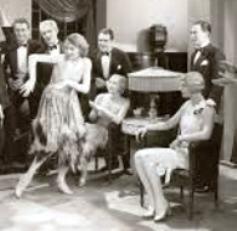 Continued...
Facts
about the
Jazz Age for kids
Facts
about the Jazz Age for kids
The following fact
sheet continues with facts about Jazz Age for kids.
Facts
about the
Jazz Age for kids
Jazz Age Fact 7:
Films / Movies: The new
phenomenon of the Cinema, or 'Picture Palace' started
with silent, black and white movies of the early 1920's
that were accompanied by piano or organ music. The first
all-color movie called 'Toll of the Sea' was released IN
1922. The first movie with sound effects and music, was
called Don Juan. Charlie Chaplin's popular silent comedy
'The Gold Rush' premiered on August 16, 1925. The
'talkies' started in 1927 with the 'The Jazz Singer'
starring Al Jolson -
First talking movie -
The Jazz Singer. Stars of films and movies such
as Douglas Fairbanks, Rudolph Valentino, Mary Pickford,
Buster Keaton and Mae West were idolized. The Jazz Age movies were a cheap form of entertainment and
by 1929 an average of 100 million Americans went to the
cinema every week
Jazz Age Fact 8:
Great Gatsby: The Great Gatsby
was the most famous book of the era. F. Scott Fitzgerald
published The Great Gatsby in 1925 which told the story
of the fictional Jay Gatsby and exposed the excesses of
Consumerism during the 1920s. F. Scott Fitzgerald
described the Jazz Age as “...the greatest, gaudiest
spree in history”
Jazz Age Fact
9: KKK - Ku Klux Klan: The
Resurgence of the Ku Klux Klan followed WW1. The KKK were portrayed as the
protector of traditional values and opposers of
immigration. The movement of African Americans to the
northern cities during the
Great Migration
also opposed by the KKK.
The Second KKK attracted
millions of new members and led to an increase in racial
bigotry and nativism in the Jazz Age. On August 8, 1925
more than forty thousand Klansmen famously
marched through Washington filling Pennsylvania Avenue .
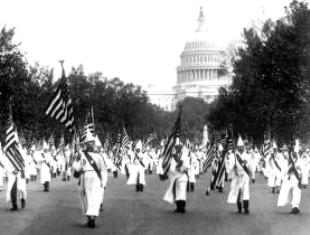
Jazz Age Fact 10:
Literature:
American authors, playwrights and poets of the Jazz Age
challenged traditional ideas and reflected the impact of
modernism in the literature of the ere. The new style of
literature reflected realistic themes and characters.
Many Jazz Age authors disillusioned by the Great War
concentrated on the negative effects of consumerism and
modernism.
Jazz Age Fact 11:
Music: Jazz music originated
in New Orleans in the early 1900s. European and African
music culture combined together with Blues, Ragtime and Dixie and
jazz was born. Louis Armstrong is credited with putting
Jazz on the musical map.
Jazz developed in the speakeasy
cellars in the cities of New York and Chicago. Not
everyone approved or appreciated jazz music. Anne
Faulkner, head of the music division of the General
Federation of Women's Clubs described jazz as "a
destructive dissonance". Jazz, ragtime and the music
from Broadway musicals dominated the Age.
The painting is by F. Winold Reiss
and entitled "Interpretation of Harlem Jazz"
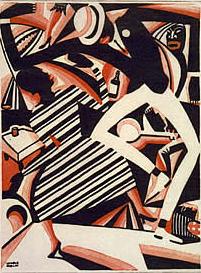
Jazz Age Fact 12:
Musicians: The famous jazz
musicians of the period included Jelly Roll Morton, King
Oliver, Paul Whiteman, Louis "Satchmo" Armstrong, ,
Bix Beiderbecke, Earl "Fatha" Hines, Coleman Hawkins,
Fletcher Henderson, Edward "Kid" Ory,
Ella Fritzgerald, Thelonious Monk, Florence Mills, Josephine Baker,
Bessie Smith "the Empress of the
Blues & Jazz" and Duke Ellington.
Jazz Age Fact
13: New York:
The Harlem Renaissance, the "flowering of Negro
literature" was centered in the Harlem neighborhood of
New York City. The cabaret form of entertainment began
in New York City and the growing number of speakeasies
during the Prohibition era of the 1920's provided many
aspiring jazz musicians with new venues. Duke Ellington
arrived in New York City and met his other musicians
such as James P. Johnson and Fats Waller. Tin Pan Alley
became the center of the music industry in New York City.
The Cotton Club was the most famous of all the Harlem
nightspots.
Jazz Age Fact
14: Poetry: The
Harlem Renaissance saw the emergence of many Black
African poets including Claude McKay whose eloquent
poetry about American racism included poems such as 'If
we must Die' and 'The Lynching'. Langston Hughes, known
as 'The Poet Laureate of Harlem' wrote 'The negro speaks
of rivers, 'The Weary Blues' and 'I too' as a
response to 'I hear America singing' by Walt Whitman.
Ezra Pound, T.S.
Elliot, Carl Sandburg, and E.E. Cummings wrote their
poetry with an increasing lack of formality and
conventional style. The first poets to write about jazz
music and the Jazz Age culture were Vachel Lindsay, Carl
Sandburg, Mina Loy, and Hart Crane.
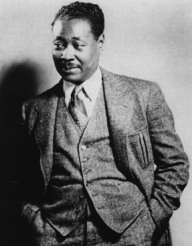
Jazz Age Fact
15: Radio: The
music of the Jazz Age was introduced to Americans due to
the introduction of large-scale radio broadcasts in
1922. Americans could listen to the new style of music
without leaving their homes of going to a jazz club in a
big city. African American Jazz musicians such as like
Armstrong initially received very little airtime because
most radio stations preferred to play the music of white
American jazz singers. Big-band jazz music, like that of
Fletcher Henderson and James Reese Europe, attracted
large radio audiences. For more facts refer to
1920's Radio and Advertising.
Jazz Age Fact
16: Slang: The
Jazz Age slang that emerged during the era were flapper,
speakeasy, ace, hooch, big cheese, jazzbos,
bootlegger, crush, cat's whiskers, the bee's knees,
gatecrasher, whoopee, floorflusher, juice joint,
splifficated, swanky, vamp, scram, lounge lizards, stool
pigeons, tommy guns and 'Dirty rats'.
Jazz Age Fact
17: Songs: The most popular songs
of the Jazz Age included "Ain't Misbehavin'", “Baby
Face”, “I Want to Be Happy”, "Sweet Georgia Brown",
"Dinah", "The Sheik of Araby", "Bye Bye Blackbird",
“Blue Skies”, “Crazy Rhythm”, “Charleston” and “Singin’
in the Rain”. George Gershwin's jazz-influenced
"Rhapsody in Blue" was released in 1927 that blended
symphonic music with jazz.
Jazz Age Fact
18: Writers:
The writers and authors of the age included F.
Scott Fitzgerald, Eugene O'Neill, Ernest Hemingway,
William Faulkner and T.S. Eliot. The famous writers of
the Harlem Renaissance were Zora Neil Hurston, Claude
McKay, Langston Hughes, Nella Larsen, Countee Cullen,
Alain Locke and Dorothy West
Facts
about the
Jazz Age for kids
Facts
about
Jazz Age for kids
For visitors interested in the history of
the Jazz Age refer to the following articles:
Black
History for kids: Important People and Events
For visitors interested in African American History
refer to
Black History -
People and Events.
A useful resource for
teachers, kids, schools and colleges undertaking projects for the
Black History Month.
Jazz Age for kids
The article on the
Jazz Age provides
detailed facts and a summary of the most important events and dates in the history of the
United States
- a crash course in
American History. The following video will
give you additional important facts, history and dates about the
personal and political lives of all the US Presidents.
Facts on
the Jazz Age
●
Interesting Facts about Jazz Age for kids and schools
●
Key events
and Jazz Age for kids
●
The Jazz Age, an important period in US history
●
Important topics of the Jazz Age
●
Fast, fun facts about the Age in American history
●
Interesting facts and info about the Jazz Age
● Fast, Fun Facts about the
Jazz Age for schools,
homework, kids and children |